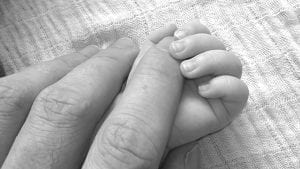Trisomy 18 (Edwards Syndrome)
What is trisomy 18 (Edwards syndrome)?
Trisomy 18 (a.k.a. Edwards syndrome), is a chromosomal condition associated with abnormalities in many parts of the body. Individuals with trisomy 18 often have slow growth before birth (intrauterine growth retardation) and a low birth weight. Due to the presence of several life-threatening medical problems, many individuals with trisomy 18 die before birth or within their first month. Five to 10 percent of children with this condition live past their first year, and these children often have severe intellectual disability.What are the symptoms of trisomy 18 (Edwards syndrome)?
Physical signs of Edwards syndrome include:- Low birthweight
- A small, abnormally shaped head
- A small jaw and mouth
- Long fingers that overlap, with underdeveloped thumbs and clenched fists
- Low-set ears
- Smooth feet with rounded soles
- A cleft lip and palate
- An exomphalos (where the intestines are held in a sac outside the stomach)
- Heart and kidney problems
- Feeding problems – leading to poor growth
- Breathing problems
- Hernias in the wall of the stomach
- Bone abnormalities – such as a curved spine
- Frequent infections of the lungs and urinary system
- A severe learning disability
What causes trisomy 18 (Edwards syndrome)?
Trisomy 18 is caused by an error in cell division, known as meiotic disjunction. When this happens, instead of the normal pair, an extra chromosome 18 results (a triple) in the developing baby and disrupts the normal pattern of development in significant ways that can be life-threatening, even before birth.How is trisomy 18 (Edwards syndrome) diagnosed?
Trisomy 18 can either be diagnosed before or after birth: During pregnancy: Pregnant women are offered screening for Edwards’ syndrome between 10 and 14 weeks of pregnancy. This screening test is known as the combined test, and it also screens for Down’s syndrome and Patau’s syndrome. During the combined test, the patient will have a blood test and a special ultrasound scan where the fluid at the back of the baby’s neck (nuchal translucency) is measured. If the combined test shows an increased change of trisomy 18, further diagnostic tests will be required, to check the baby’s cells. There are two different ways of getting this sample of cells – chorionic villus sampling, which collects a sample from the placenta, or amniocentesis, which collects a sample of the amniotic fluid from around your baby. After birth: If doctors believe a baby has Edwards syndrome when it is born, they will take a blood sample from the baby. This will be examined to see if the baby’s cells have extra copies of chromosome 18.What are the treatments for trisomy 18 (Edwards syndrome)?
There is currently no cure or treatment for trisomy 18, but various therapies can help manage its symptoms.Where can I find out more about trisomy 18 (Edwards syndrome)?
Trisomy 18 Articles

Edwards Syndrome and Down Syndrome Identified in Ancient DNA
Jessica Lynn
April 12, 2024
Read More »


A Global Perspective is Crucial to Improve Rare Disease Care, Part 2
Rose Duesterwald
February 8, 2023
Read More »








